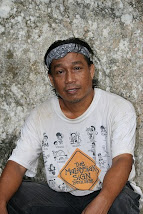
The Last Carnibal Is Still Alive
Orang Asli - People of The
Who are the Orang Asli ?
The Orang Asli (Malay for "Original People") are the aborigines of Peninsular Malaysia.¹ Most of them descend from the Hoabinhians, stone tool-using hunter-gatherers who occupied the peninsula as early as 11,000 B.C. (Bellwood 1997: 155-171). Today Orang Asli comprise at least nineteen culturally and linguistically distinct groups. The largest are the Semai, Temiar, Jakun (Orang Hulu), and Temuan. In 1999 they numbered about 105,000, less than 0.5% of the total Malaysian population (Megan 1999). Orang Asli once were thinly scattered throughout the peninsula, but most were pushed back into the interior montane forests as the Malay population grew on the coastal plains and major river valleys. Most Orang Asli still live in rural and remote areas. Until recently they lived by various combinations of hunting, fishing, gathering, swidden farming, aboriculture, and trading forest products. Nowadays land development projects and government programs have turned many into rural peasants or day laborers.
Since 1961 Malaysian officials have expressed a desire to “integrate” Orang Asli into the Malaysian “mainstream.” This has come to mean bringing them into the market economy, asserting political control over them, and assimilating them into the Malay ethnic category. Yet, despite continuous efforts by the federal Department of Aboriginal Affairs (Jabatan Hal Ehwal Orang Asli, or JHEOA), most Orang Asli still live on the fringes of Malaysian society, cut off from most social services, poorly educated, making a meager living. A 1993 census showed 80.8% of Orang Asli in poverty, 49.9% among the “poorest of the poor” (rakyat termiskin in Malay) (Ikram Jamaludin 1997; see also Todd 1990: 12; Mohd Tap 1990: 328, 471-472). Their health and nutrition are at about the same level as in 1960 (Khor Geok Lin 1994; Baer 1999). (Kirk Endicott and Robert Knox Dentan)
The Orang Asli, numbering nearly 98,494 people (1991 Survey), are made-up of 18 ethno linguistic groups living in Malaysia. They reside in scattered villages, camps and estates, in the rainforest, mountains and coasts, as well as in some towns and cities.
The Orang Asli are regarded as being the original inhabitants of
There are 18 different tribes of Orang Asli within Peninsular Malaysia and have been categorized based on ethnic and cultural criteria.
Orang Asli population by groups and subgroups (2000)
| NEGRITO | SENOI | PROTO MALAY |
| Kensiu (254) | Che Wong (234) | Temuan (18,560) |
| Kintak (150) | Mahmeri (3,503) | Semelai (5,026) |
| Lanoh (173) | Jahut (2,594) | Jakun (21,484) |
| Jahai (1,244) | Semoq Beri (2,348) | Orang Kanaq (73) |
| Mendriq (167) | Semai (34,248) | Orang Kuala (3,221) |
| Bateq (1.519) | Temiar (17,706) | Orang Seletar (1,037) |
| 3,507 | 60,633 | 49,401 |
| Total: 113,541 | ||
Each group Orang Asli has its own language, history and customs that are distinct from each other. It is popularly believed that the first Orang Asli may have come to
Bateq : (Sub-tribes: Bateq Teq, Bateq Deq, Bateq Iga, Bateq Nong)
The Batek tribe roams a big part of the Pahang rainforest; Kenong Rimba and Taman Negara, but each clan consists of just 10 - 30 individuals.
The Bateq or Batek are hunters and gatherers and they are nomadic. Their movements can be traced to the availability of food in the area. Hunting for small animals such as mousedeers, monkeys, squirrels and birds plus gathering edible tubers and wild vegetation can sustain them for a period of time. The Batek are fond of hunting for the great Argus pheasant. The hunter first searches for signs of its presence, which to the trained eye is not difficult at all!
The Batek erect makeshift huts surrounding an open fire. There is an abandoned settlement close to the entrance of the park.
We organized several tours that link with the Orang Asli's of several tribes. Please click here to see the tours that we offers. (Special Interest Tour Packages)








